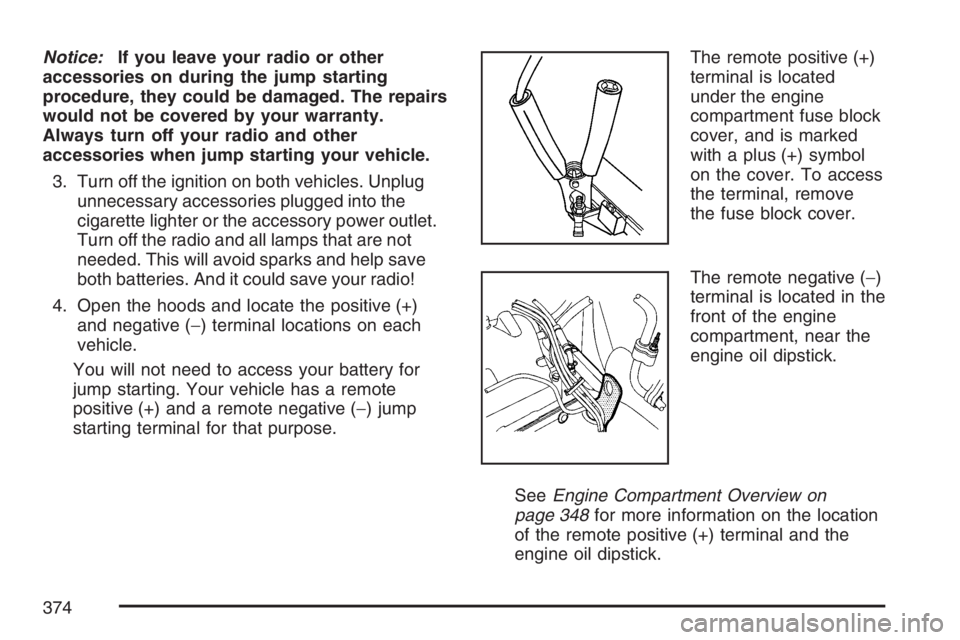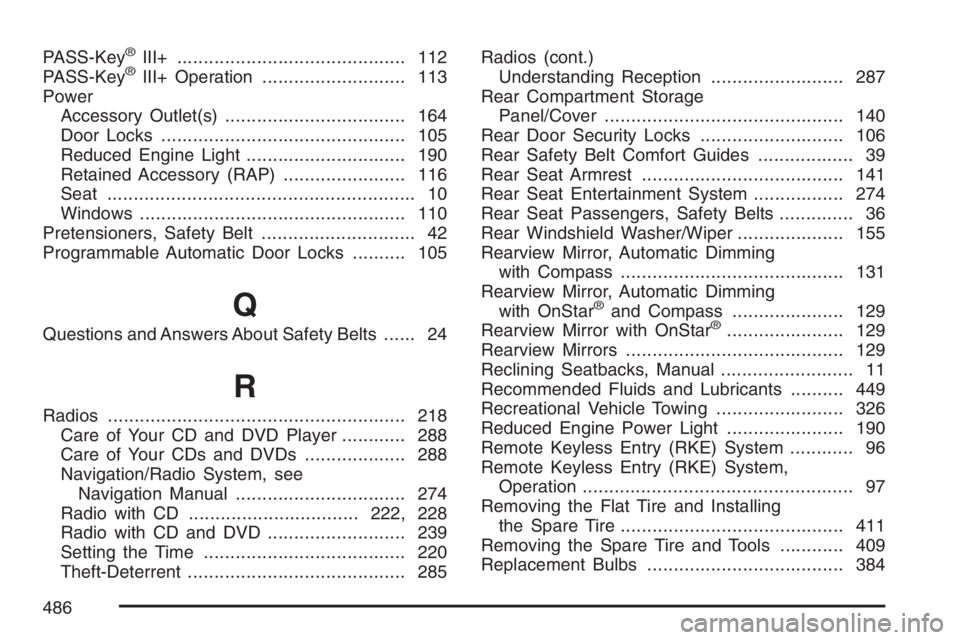2007 PONTIAC TORRENT radio
[x] Cancel search: radioPage 288 of 490

Care of Your CDs and DVDs
Handle CDs carefully. Store them in their original
cases or other protective cases and away from
direct sunlight and dust. The CD player scans the
bottom surface of the disc. If the surface of a
CD is damaged, such as cracked, broken,
or scratched, the CD does not play properly or not
at all. If the surface of a CD is soiled, take a
soft, lint free cloth or dampen a clean, soft cloth in
a mild, neutral detergent solution mixed with
water, and clean it. Make sure the wiping process
starts from the center to the edge.
Do not touch the bottom side of a CD while
handling it; this could damage the surface. Pick up
CDs by grasping the outer edges or the edge of
the hole and the outer edge.
Care of the CD and DVD Player
The use of CD lens cleaners for CDs is not
advised, due to the risk of contaminating the lens
of the CD optics with lubricants internal to the
CD mechanism.
Multi-Band Antenna
The multi-band antenna is located on the roof of
your vehicle. This type of antenna is used with
an AM/FM radio, and if your vehicle has the
OnStar
®and/or the XM™ Satellite Radio Service
System. Keep this antenna clear of snow and
ice build up for clear radio reception. If your vehicle
has a sunroof, the performance of the radio
system may be affected if the sunroof is open.
Loading items onto the roof of your vehicle
can interfere with the performance of the radio
system and, if your vehicle has this feature,
OnStar
®. Make sure the multi-band antenna is not
obstructed.
288
Page 374 of 490

Notice:If you leave your radio or other
accessories on during the jump starting
procedure, they could be damaged. The repairs
would not be covered by your warranty.
Always turn off your radio and other
accessories when jump starting your vehicle.
3. Turn off the ignition on both vehicles. Unplug
unnecessary accessories plugged into the
cigarette lighter or the accessory power outlet.
Turn off the radio and all lamps that are not
needed. This will avoid sparks and help save
both batteries. And it could save your radio!
4. Open the hoods and locate the positive (+)
and negative (−) terminal locations on each
vehicle.
You will not need to access your battery for
jump starting. Your vehicle has a remote
positive (+) and a remote negative (−) jump
starting terminal for that purpose.The remote positive (+)
terminal is located
under the engine
compartment fuse block
cover, and is marked
with a plus (+) symbol
on the cover. To access
the terminal, remove
the fuse block cover.
The remote negative (−)
terminal is located in the
front of the engine
compartment, near the
engine oil dipstick.
SeeEngine Compartment Overview on
page 348for more information on the location
of the remote positive (+) terminal and the
engine oil dipstick.
374
Page 395 of 490

Tire Pressure Monitor System
Your vehicle has a Tire Pressure Monitor System
(TPMS). This system uses radio and sensor
technology to check tire pressure levels. TPMS
sensors are mounted onto each tire and wheel
assembly, except for the spare tire. The TPMS
sensors monitor the air pressure in your vehicle’s
tires and transmit tire pressure readings to a
receiver located in the vehicle.
Each tire, including the spare (if provided), should
be checked monthly when cold and in�ated to
the in�ation pressure recommended by the vehicle
manufacturer on the vehicle placard or tire
in�ation pressure label. (If your vehicle has tires of
a different size than the size indicated on the
vehicle placard or tire in�ation pressure label, you
should determine the proper tire in�ation
pressure for those tires.)As an added safety
feature, your vehicle
has been equipped with
a tire pressure
monitoring system
(TPMS) that illuminates
a low tire pressure
telltale when one
or more of your tires is
signi�cantly
under-in�ated.
Accordingly, when the low tire pressure telltale
illuminates, you should stop and check your tires
as soon as possible, and in�ate them to the
proper pressure. Driving on a signi�cantly
under-in�ated tire causes the tire to overheat and
can lead to tire failure. Under-in�ation also
reduces fuel efficiency and tire tread life, and may
affect the vehicle’s handling and stopping ability.
395
Page 399 of 490

Federal Communications Commission
(FCC) and Industry and Science Canada
The Tire Pressure Monitor System (TPMS)
operates on a radio frequency and complies with
Part 15 of the FCC Rules. Operation is subject
to the following two conditions:
1. This device may not cause harmful
interference.
2. This device must accept any interference
received, including interference that may
cause undesired operation.
The Tire Pressure Monitor System (TPMS)
operates on a radio frequency and complies with
RSS-210 of Industry and Science Canada.
Operation is subject to the following two
conditions:
1. This device may not cause interference.
2. This device must accept any interference
received, including interference that may
cause undesired operation of the device.
Changes or modi�cations to this system by other
than an authorized service facility could void
authorization to use this equipment.
Tire Inspection and Rotation
Tires should be rotated every 5,000 to 8,000 miles
(8 000 to 13 000 km).
Any time you notice unusual wear, rotate your
tires as soon as possible and check wheel
alignment. Also check for damaged tires or wheels.
SeeWhen It Is Time for New Tires on page 401
andWheel Replacement on page 405for
more information.
The purpose of regular rotation is to achieve more
uniform wear for all tires on the vehicle. The
�rst rotation is the most important. SeeScheduled
Maintenance on page 440for scheduled rotation
intervals.
When rotating your tires, always use the correct
rotation pattern shown here.
399
Page 433 of 490

Fuses Usage
7 Driver’s Side Turn Signal
8 Door Locks
9Automatic Occupant Sensing
Module
10 Power Mirrors
11 Passenger’s Side Turn Signal
12 Ampli�er
13 Steering Wheel Illumination
SPARE Spare
SPARE Spare
SPARE Spare
SPARE Spare
SPARE Spare
14 Infotainment
15Climate Control System, Remote
Function Actuator
16 Canister Vent
17 Radio
18 ClusterFuses Usage
19 Ignition Switch
20 Body Control Module
21 OnStar
®
22Center High-Mounted Stoplamp,
Dimmer
23 Interior Lights
Relays Usage
RAP RLY Retained Accessory Power Relay
REAR DEFOG
RLYRear Defogger Relay
Circuit
BreakersUsage
PWR WNDW Power Windows
PWR SEATS Power Seats
EMPTY Empty
Misc. Usage
PLR Fuse Puller
433
Page 478 of 490

Audio System(s) (cont.)
Care of Your CDs and DVDs................... 288
Navigation/Radio System, see
Navigation Manual................................ 274
Radio with CD................................222, 228
Radio with CD and DVD.......................... 239
Setting the Time...................................... 220
Theft-Deterrent Feature............................ 285
Understanding Radio Reception............... 287
Automatic Headlamp System....................... 160
Automatic Transaxle
Fluid........................................................ 357
Operation................................................. 119
B
Battery........................................................ 372
Electric Power Management..................... 163
Run-Down Protection............................... 164
Battery Warning Light.................................. 179
Before Leaving on a Long Trip.................... 313
Brake
Anti-Lock Brake System (ABS)................. 295
Emergencies............................................ 297
Parking.................................................... 122
System Warning Light.............................. 180
Brakes........................................................ 369Braking....................................................... 294
Braking in Emergencies............................... 297
Break-In, New Vehicle................................. 114
Bulb Replacement....................................... 380
Halogen Bulbs......................................... 380
Headlamps, Front Turn Signal,
Sidemarker, and Parking Lamps........... 381
License Plate Lamps................................ 383
Replacement Bulbs.................................. 384
Taillamps, Turn Signal, Stoplamps
and Back-up Lamps.............................. 382
Buying New Tires........................................ 401
C
Calibration..........................................129, 131
California Fuel............................................. 342
California Proposition 65 Warning................ 340
Canadian Owners........................................... 3
Capacities and Speci�cations...................... 436
Carbon Monoxide..............107, 127, 316, 328
Care of
Safety Belts............................................. 424
Your CD and DVD Player........................ 288
Your CDs and DVDs................................ 288
Cargo Lamp................................................ 162
CD, MP3 ............................................257, 264
478
Page 485 of 490

Mirrors (cont.)
Automatic Dimming Rearview with
OnStar
®and Compass......................... 129
Manual Rearview Mirror........................... 129
Manual Rearview Mirror with OnStar
®...... 129
Outside Convex Mirrors............................ 133
Outside Power Mirrors............................. 132
MP3 ...................................................257, 264
MyGMLink.com............................................ 459
N
Navigation/Radio System, see Navigation
Manual..................................................... 274
New Vehicle Break-In.................................. 114
Normal Maintenance Replacement Parts..... 450
O
Odometer.................................................... 174
Odometer, Trip............................................ 174
Off-Road Recovery...................................... 303
Oil
Change Engine Oil Light.......................... 188
Engine..................................................... 349
Pressure Light.......................................... 187
Oil, Engine Oil Life System......................... 352Older Children, Restraints............................. 43
Online Owner Center................................... 459
OnStar
®System, see OnStar®Manual........ 133
Other Warning Devices................................ 150
Outlet Adjustment........................................ 170
Outlet(s), Accessory Power.......................... 164
Outside
Convex Mirrors........................................ 133
Power Mirrors.......................................... 132
Overheated Engine Protection
Operating Mode....................................... 362
Owner Checks and Services....................... 445
Owners, Canadian.......................................... 3
P
Paint, Damage............................................ 428
Park (P)
Shifting Into............................................. 123
Shifting Out of......................................... 125
Parking
Brake....................................................... 122
Over Things That Burn............................ 126
Passenger Airbag Status Indicator............... 177
Passenger Compartment Air Filter............... 170
Passenger Sensing System........................... 82
Passing....................................................... 303
485
Page 486 of 490

PASS-Key®III+........................................... 112
PASS-Key®III+ Operation........................... 113
Power
Accessory Outlet(s).................................. 164
Door Locks.............................................. 105
Reduced Engine Light.............................. 190
Retained Accessory (RAP)....................... 116
Seat.......................................................... 10
Windows.................................................. 110
Pretensioners, Safety Belt............................. 42
Programmable Automatic Door Locks.......... 105
Q
Questions and Answers About Safety Belts...... 24
R
Radios........................................................ 218
Care of Your CD and DVD Player............ 288
Care of Your CDs and DVDs................... 288
Navigation/Radio System, see
Navigation Manual................................ 274
Radio with CD................................222, 228
Radio with CD and DVD.......................... 239
Setting the Time...................................... 220
Theft-Deterrent......................................... 285Radios (cont.)
Understanding Reception ......................... 287
Rear Compartment Storage
Panel/Cover............................................. 140
Rear Door Security Locks........................... 106
Rear Safety Belt Comfort Guides.................. 39
Rear Seat Armrest...................................... 141
Rear Seat Entertainment System................. 274
Rear Seat Passengers, Safety Belts.............. 36
Rear Windshield Washer/Wiper.................... 155
Rearview Mirror, Automatic Dimming
with Compass.......................................... 131
Rearview Mirror, Automatic Dimming
with OnStar
®and Compass..................... 129
Rearview Mirror with OnStar®...................... 129
Rearview Mirrors......................................... 129
Reclining Seatbacks, Manual......................... 11
Recommended Fluids and Lubricants.......... 449
Recreational Vehicle Towing........................ 326
Reduced Engine Power Light...................... 190
Remote Keyless Entry (RKE) System............ 96
Remote Keyless Entry (RKE) System,
Operation................................................... 97
Removing the Flat Tire and Installing
the Spare Tire.......................................... 411
Removing the Spare Tire and Tools............ 409
Replacement Bulbs..................................... 384
486